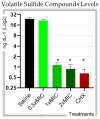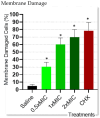Lavandula angustifolia Essential Oil Inhibits the Ability of Fusobacterium nucleatum to Produce Volatile Sulfide Compounds, a Key Components in Oral Malodor
- PMID: 38998934
- PMCID: PMC11243465
- DOI: 10.3390/molecules29132982
Lavandula angustifolia Essential Oil Inhibits the Ability of Fusobacterium nucleatum to Produce Volatile Sulfide Compounds, a Key Components in Oral Malodor
Abstract
Oral malodor still constitutes a major challenge worldwide. A strong effort is invested in eliminating volatile sulfur compound-producing oral bacteria through organic natural products such as essential oils. Fusobacterium nucleatum is a known volatile sulfur compound-producing bacteria that inspires oral malodor. The aim of the present study was to test the effect of lavender essential oil on the bacterium's ability to produce volatile sulfide compounds, the principal components of oral malodor. Lavender (Lavandula angustifolia) essential oil was extracted by hydrodistillation and analyzed using GC-MS. The minimal inhibitory concentration (MIC) of lavender essential oil on Fusobacterium nucleatum was determined in a previous trial. Fusobacterium nucleatum was incubated anaerobically in the presence of sub-MIC, MIC, and above MIC concentrations of lavender essential oil, as well as saline and chlorhexidine as negative and positive controls, respectively. Following incubation, volatile sulfur compound levels were measured using GC (Oralchroma), and bacterial cell membrane damage was studied using fluorescence microscopy. Chemical analysis of lavender essential oil yielded five main components, with camphor being the most abundant, accounting for nearly one-third of the total lavender essential oil volume. The MIC (4 µL/mL) of lavender essential oil reduced volatile sulfur compound secretion at a statistically significant level compared to the control (saline). Furthermore, the level of volatile sulfur compound production attributed to 1 MIC of lavender essential oil was in the range of the positive control chlorhexidine with no significant difference. When examining bacterial membrane damage, 2 MIC of lavender essential oil (i.e., 8 µL/mL) demonstrated the same, showing antibacterial membrane damage values comparative to chlorhexidine. Since lavender essential oil was found to be highly effective in hindering volatile sulfur compound production by Fusobacterium nucleatum through the induction of bacterial cell membrane damage, the results suggest that lavender essential oil may be a suitable alternative to conventional chemical-based anti-malodor agents.
Keywords: Fusobacterium nucleatum; Lavandula angustifolia; volatile sulfide compounds.
Conflict of interest statement
The authors declare no conflict of interest.
Figures




Similar articles
-
Effect of Sublethal Blue Light on Herbal Extract Activity Against Volatile Sulfide Compound Production by Fusobacterium nucleatum.Photochem Photobiol. 2021 Mar;97(2):443-447. doi: 10.1111/php.13332. Epub 2020 Sep 25. Photochem Photobiol. 2021. PMID: 32916756
-
Investigation of the chemical composition-antibacterial activity relationship of essential oils by chemometric methods.Anal Bioanal Chem. 2012 May;403(4):1007-18. doi: 10.1007/s00216-012-5866-1. Epub 2012 Mar 3. Anal Bioanal Chem. 2012. PMID: 22389175
-
Chemical Composition of Two Different Lavender Essential Oils and Their Effect on Facial Skin Microbiota.Molecules. 2019 Sep 8;24(18):3270. doi: 10.3390/molecules24183270. Molecules. 2019. PMID: 31500359 Free PMC article.
-
Biological activities of lavender essential oil.Phytother Res. 2002 Jun;16(4):301-8. doi: 10.1002/ptr.1103. Phytother Res. 2002. PMID: 12112282 Review.
-
Lavandula × intermedia-A Bastard Lavender or a Plant of Many Values? Part I. Biology and Chemical Composition of Lavandin.Molecules. 2023 Mar 25;28(7):2943. doi: 10.3390/molecules28072943. Molecules. 2023. PMID: 37049706 Free PMC article. Review.
Cited by
-
The Effect of Limosilactobacillus fermentum MG4717 on Oral Health and Biosafety.Microorganisms. 2025 Jul 7;13(7):1600. doi: 10.3390/microorganisms13071600. Microorganisms. 2025. PMID: 40732109 Free PMC article.
References
MeSH terms
Substances
LinkOut - more resources
Full Text Sources
Medical
Molecular Biology Databases
Miscellaneous

